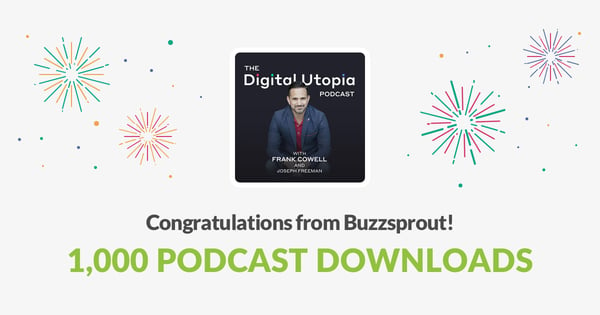Lessons Learned From Our First Year of Hosting A Podcast
by DJ Shirley | Updated Jun 6, 2025
Is your business exploring launching a podcast to increase your brand's exposure or support your existing audience? With the close of 2020, Digitopia proudly closed the chapter of our first year of recording The Digital Utopia Podcast. A podcast dedicated to providing business leaders a resource to help navigate and overcome common hurdles faced by growing organizations.
Through the planning, recording, promotion, and pivots needed to continually grow the podcast's exposure, we consolidated several "Lessons Learned" we wanted to share as a resource.
One of the first concerns we had and have heard from others when looking into activating a podcast is around audience. But, fear not, you should be able to find an audience specific to your niche, with more than 104 million Americans (roughly ⅓) consume podcasts regularly, according to Edison Research.
Knowing the volume of podcast listeners in combination with research featured on Forbes...
...39% of small and medium-sized business owners consume podcasts weekly.
With a valid audience and focus, the Digital Utopia Podcast was activated in early 2020.
Lessons Learned:
- Find Your Format
- Always Prep
- Take Time to Setup
- Stay Consistent
Find Your Format
Is the show going to feature a single host, multiple hosts, or a panel? Are you going to conduct guest interviews? Are you aiming to have short or long discussions?
It's important to find the format that best aligns with your style. Two personalities we reference often are Joe Rogan and Gary Vanderchuck. Joe Rogan's episodes easily exceed 2 hours on average, and while each episode is focused on his guest, they follow a more fluid conversation and can end up talking about a wide range of topics. Gary V, will have guests on but often keeps the episode concise and focused on a specific topic. Both formats work great for the individual. There are a number of varying formats to try based on the intent of your podcast.
Don't be afraid to try different formats as you evolve so you can find the style that best suits you and your audience.
One example of the Digitopia podcast changing overtime was the average episode length. With the initial stay at home orders and many organizations shifting to a remote work policy at the start of COVID-19. The commute to work, a typical time to listen to podcasts, was no longer part of the daily routine. After conducting a small survey, we concluded our audience was more interested in shorter episodes due to the new structure of their daily routines. We started to shift to shorter episodes by splitting a big topic into smaller segments.
Always Prep
Spending the time to coordinate before each episode to review notes and key points has been essential to keep our episodes focused. The practice allows our recordings to flow naturally and avoid topic drifting.
When the Digitopia podcast team is recording and the conversation starts to drift away from the main topic we swing back or wrap it up. This is our stance but your format may allow more flexibility. Our stance is based on the persona of our audience, a business leader who is typically to the point and onto the next. There is too much great content out in the world for people to waste time with fluff and we strive to be that fluff free resource. Of course, we want to let the personalities of our hosts shine but always keep the topic of the episode at heart. Deliver value and only value.
Take Time to Setup
Regardless of your podcast's format, it's critical to focus on the setup of your environment and equipment.
Dedicate the time to set up your environment and equipment properly. 10 to 15 extra minutes spent in pre-production can save you a huge amount of time post-production if something did not record well.
Please note, the emphasis of this recommendation is on the environment, not equipment. If you are just starting out, don't feel like you need to allocate a large budget to your initial equipment setup. You can activate a reliable podcast setup for less than $200. Additionally, expensive (high-end) equipment often requires a seasoned level of experience to use and may be more trouble than it is worth if you are just starting out.
Stay Consistent
If you are activating a podcast for your business, be sure to carve out a time for any involved in the recording and production process. If either area fails, it will impact your production timeline.
Recommendation: Lock a regular time in your schedule that is devoted to the podcast. This helps you stay on track and maintain a consistent release schedule for your episodes.
We are proud of the progress we have made with the Digitopia Utopia Podcast, and just this week, we hit over 1,000 downloads.
 A big thank you to all of our listeners. We appreciate your support! You can subscribe to the show on whichever platform you listen to audio, Apple, Spotify, Amazon, Google, and everything in between.
A big thank you to all of our listeners. We appreciate your support! You can subscribe to the show on whichever platform you listen to audio, Apple, Spotify, Amazon, Google, and everything in between.
If you have questions about setting up the podcast or which tools we use, don't hesitate to reach out to me on LinkedIn directly. Happy to talk shop.











